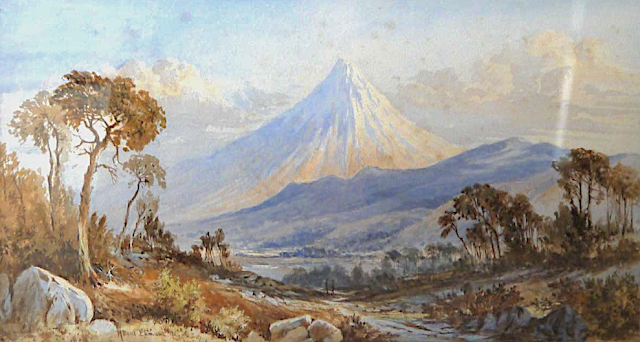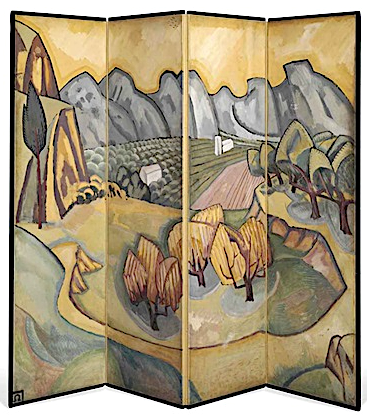
SIDNEY RICHARD PERCY (1821-1886)
Mount Snowdon (1, 085 m -3,560 ft)
United Kingdom (Wales)
In Llyn-y-Ddinas, North Wales, Mount Snowdon in the background (1873), Oil on canvas, 45.5 x 76 cm. Private Collection
The mountain
Mount Snowdon (1,
085 m -3,560 ft),Yr Wyddfa in welsh, is the highest mountain in Wales
and the highest point in the British Isles south of the Scottish
Highlands. A 1682 survey estimated that the summit of Snowdon was at a
height of 1,130 m - 3,720 feet ; in 1773, Thomas Pennant quoted a later
estimate of 1,088 m- 3,568 ft above sea level at Caernarfon. Recent
surveys give the height of the summit as 1,085 m -3,560 ft. The name
Snowdon is from the Old English for "snow hill", while the Welsh name –
Yr Wyddfa – means "the tumulus" or "the barrow", which may refer to the
cairn thrown over the legendary giant Rhitta Gawr after his defeat by
King Arthur. As well as other figures from Arthurian legend, the
mountain is linked to a legendary Afanc (water monster) and the Tylwyth
Teg (fairies). Mount Snowdon is located in Snowdonia National Park (Parc
Cenedlaethol Eryri) in Gwynedd. It has been described as "probably the
busiest mountain in Britain", with approximately 444,000 people having
walked up the mountain in 2016. It is designated as a national nature
reserve for its rare flora and fauna. The rocks that form Snowdon were
produced by volcanoes in the Ordovician period, and the massif has been
extensively sculpted by glaciation, forming the pyramidal peak of
Snowdon and the Arêtes of Crib Goch and Y Lliwedd. The cliff faces on
Snowdon, including Clogwyn Du'r Arddu, are significant for rock
climbing, and the mountain was used by Edmund Hillary in training for
the 1953 ascent of Mount Everest.
The summit can be reached by a number of well-known paths, and by the
Snowdon Mountain Railway, a rack and pinion railway opened in 1896 which
carries passengers the 4.7 miles (7.6 km) from Llanberis to the summit
station.
The painter
Sidney Richard Percy
had his greatest success painting landscapes of grazing cattle,
typically set against backgrounds of distant mountains and cloudy skies.
The prevailing hues of his landscapes are earth tones and soft greens,
accentuated by a variety of pastel hues. The detail in his work is part
of its appeal, and "it was remarked that his rocks and stones were
sufficiently accurate to have served as illustrations to the writings of
Sir Roderick Murchison, the popular 19th-century geologist."
Llyn-y-Ddinas, North Wales, (see above) one of his more popular works on the
internet, displays these qualities. He also painted landscapes of farm
fields, wheel-rutted country roads, and the occasional boat scene on a
lake. Although he generally painted in oils, a number of small
watercolors on cardboard exist, typically unsigned, that are his work.
The family, and his son the painter Herbert Sidney Percy in particular,
referred to these as "potboilers", meaning that they were quickly, and
often crudely executed, yet easily and cheaply sold "to put food on the
table" when working on larger, more time-consuming oils for exhibition,
or commissions. Many of these watercolor "potboilers" were done in the
field, and then brought back to the studio to refer to when executing a
more formal oil on canvas.
Sidney Richard Percy was extremely
popular during the early part of his career, which for a short time
brought him a fair amount of income. Among his patrons during this time
was Prince Albert the Royal consort who in 1854 gave Percy's landscape
of A view of Llyn Dulyn, North Wales, which had just been exhibited at
the Royal Academy, as a gift to his wife Queen Victoria. This painting
still hangs today in the Royal Collection. Unfortunately Sidney Richard
Percy outlived his popularity, and the art world was more excited about
impressionism and other styles than landscapes when he died. Today
though, his work is much sought after, and his better paintings bring
much higher prices in auction than any of those of his brethren in the
Williams family.
When the Athenaeum in 1886 (i. 592) ran an obituary
for Sidney Richard Percy they called him, "the well-known and popular
painter, founder of the so-called School of Barnes . . ." Although
depending on the context of what is meant by the so-called Barnes
School, this is a bit of an injustice to his father Edward Williams,
whom it might be argued is the founder of the Barnes School of painters,
but it illustrates the popularity that Sidney Richard Percy held with
the art-buying public of his day.
__________________________________________
2021 - Wandering Vertexes / Mountain paintings
By Francis Rousseau















